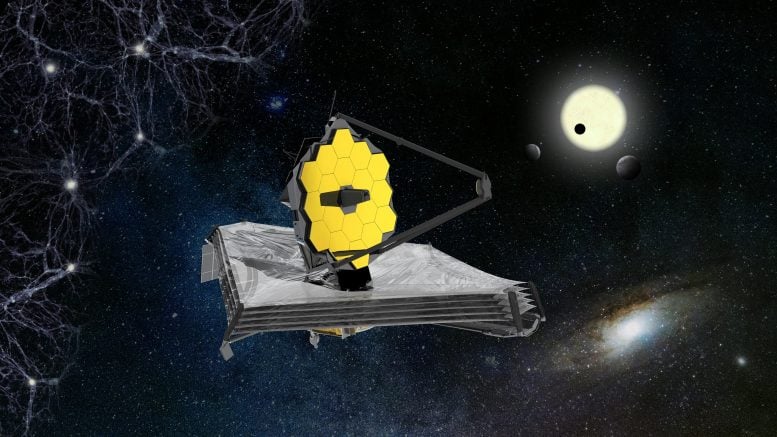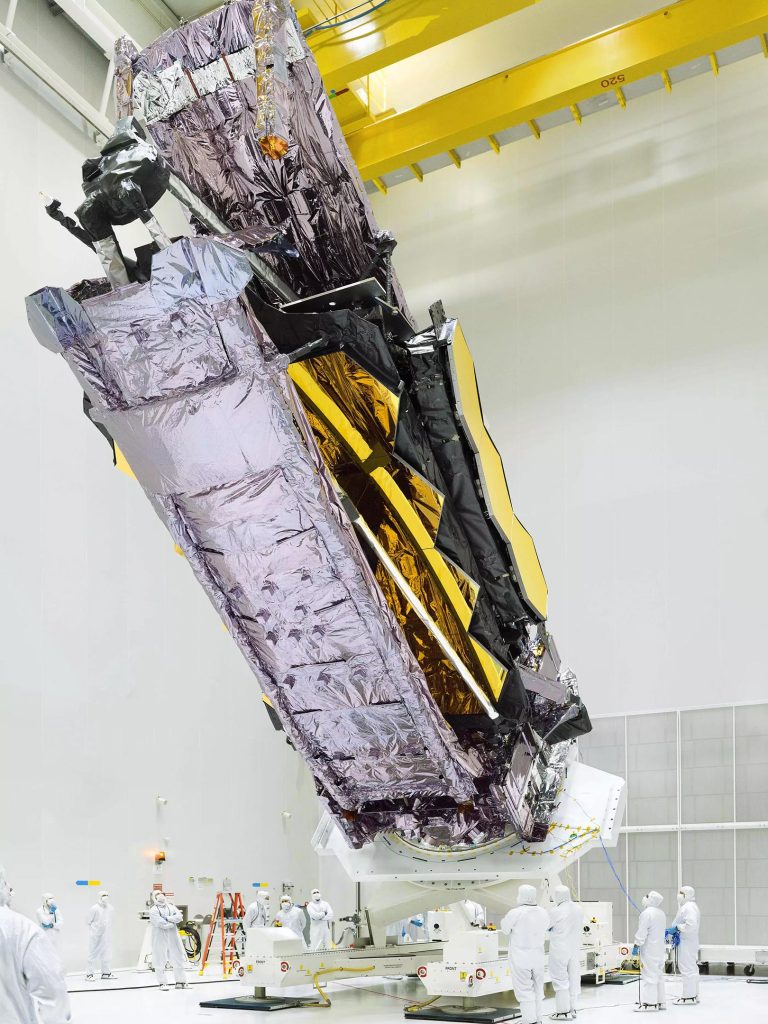
The James Webb Space Telescope is a space observatory to see further into the Universe than ever before. It is designed to answer outstanding questions about the Universe and to make breakthrough discoveries in all fields of astronomy. Webb will observe the Universe’s first galaxies, reveal the birth of stars and planets, and look for exoplanets with the potential for life. Closer to home, Webb will also look at our own Solar System in new light. Webb is an international partnership between NASA, ESA and CSA. The mission launches on an Ariane 5 from Europe’s Spaceport in French Guiana. As well as launch services, ESA contributes to two of the four science instruments, as well as personnel to support mission operations. Credit: ESA/ATG medialab
Interview with Oliver Krause from the Max Planck Institute for Astronomy about the James Webb Space Telescope.
It will be the largest observatory ever stationed in space. On December 25, the six-and-a-half-ton James Webb Space Telescope set off on its mission from the European Kourou Cosmodrome in French Guiana on an Ariane 5 rocket. It will travel to its observation post more than one million kilometers from Earth. Over the next few years, it will peer deeper into the universe than any telescope before it. What are the special features of the cosmic observatory? And what “Made in Germany” technology does it carry on board? Questions for Oliver Krause from the Max Planck Institute for Astronomy in Heidelberg. His team played a key role in the development of the space telescope.
Mr. Krause, the James Webb Space Telescope is often referred to as the “Hubble successor.” But there are considerable differences. What are they?
Oliver Krause: First, the James Webb Space Telescope has a much larger primary mirror than Hubble – six and a half meters compared with just under two and a half meters in diameter. While Hubble operates mainly in visible light, the James Webb Space Telescope is an extremely sensitive infrared telescope in keeping its scientific objectives. Because such an observatory and its scientific instruments have to be operated at temperatures ranging from -266 to -223°C, the two space telescopes also differ significantly in their design. For example, the James Webb Space Telescope features a multi-layered solar shield the size of a tennis court to protect it from thermal radiation from the sun, earth, and moon. The observation sites are also different. Unlike Hubble, the Webb telescope will not circle our planet in an orbit of only 500 km. Instead, it will move around the sun 1.5 million km away from the earth in Lagrange point L2.

Oliver Krause is a scientist at the Max Planck Institute for Astronomy and leads a team that has done considerable work on the James Webb Space Telescope. Credit: MPIA
Why is this necessary? What is the benefit of stationing the telescope in the Lagrange point?
Lagrange point L2 makes it possible to position the Sun, the Earth, and the James Webb telescope as if they were strung on a string of pearls, thereby allowing the telescope to always look into the cold universe in the shadow of the protective shield. In the course of a year, the entire sky area will then also be accessible to the telescope. However, unlike Hubble, the observatory cannot be maintained at this great distance. Therefore, everything on board must function with maximum reliability because astronaut visits will not be possible.
The Hubble and James Webb telescopes both work in space. Do you see any similarities there?
Yes, there is a common feature that ultimately justifies the designation “Hubble successor”: Both observatories are equipped with powerful instruments that allow observations using various methods from astronomy and astrophysics. Both satellites are also operated by the Space Telescope Science Institute in Baltimore. And what’s more: Like Hubble, the James Webb Space Telescope will expand what can be observed by many orders of magnitude. It is expected that the James Webb Space Telescope will provide fundamental and ground-breaking new insights into the cosmos – much like the Hubble has already done.
The James Webb Space Telescope operates in the infra-red part of the spectrum, which is invisible to the human eye. Will it be able to provide images at all?
Onboard, there are several cameras, the sensitivity of which begins in the red spectral range. This is still perceptible to the eye and extends to a wavelength of 28 µm. Especially the images obtained in the near infra-red will look quite similar to photos in the visible spectral range. However, it is important to remember that these are false color composites that are translated into the visual domain.
How is the Max Planck Institute for Astronomy involved with the James Webb Telescope?
Our Institute is a main partner of the MIRI instrument. This is a camera and spectrometer for the long-wave range between 5 and 28 µm. The entire instrument was developed and built by a consortium of European research institutes. The detectors and cooling machine of the MIRI come from the US. Because of its technological expertise, the Max Planck Institute for Astronomy is responsible for all moving parts – or wheel mechanisms – that can be used to switch optically between different observation methods. Another instrument on the James Webb telescope, the multi-object spectrograph NIRSpec, was built by a European industrial consortium led by the space agency ESA. The ESA insisted that the team from our Institute also be responsible for developing the filter and grating wheel. Because the mechanisms of moving parts can easily fail, their construction is particularly critical. We are therefore quite proud to have contributed these sophisticated components to the mission. Because only then can the instruments on board be used to their fullest capacity.

Origami in space: Because of its size, the James Webb Space Telescope cannot be transported “in one piece.” It is folded and stowed away in the Ariane 5 rocket and will be fully deployed only once in space. Credit: NASA / Chris Gunn
How long did you spend building these components? And did you have partners?
The construction of these mechanisms was done together with Hensoldt – formerly Carl Zeiss Optronics – in Oberkochen. The development was funded by the Max Planck Society and the German Aerospace Centre. The project started in Heidelberg back in 2000. The intensive first phase of work lasted until 2012/2013, when the instruments were delivered to NASA. However, there were repeated delays on the part of the US space agency. Since then, our team has been involved primarily in developing the data analysis pipeline and preparing for instrument operation. And, of course, in defining and preparing the scientific observations of the telescope.
The components must be “space-qualified,” so to speak. How and where did the relevant tests take place?
Testing the mechanisms and their components for their suitability for use in space was carried out at the Max Planck Institute in Heidelberg as well as in the clean room and environmental laboratories of the Hensolt and Carl Zeiss companies in Oberkochen. We made optimum use of the laboratory facilities at both sites in order to carry out the lengthy and technically demanding measurements at the extremely low temperatures of around -266°C and to establish the reliability and fulfillment of all performance requirements for subsequent operation in space.
What is the timetable after the launch? When do you expect the first results?
During the first two weeks after launch, the large sun shield and then the main mirror with its 18 individual segments will unfold. After that, the instruments will slowly cool down to operating temperature. This will take a few weeks. As the coldest instrument on board, the longest-wave instrument MIRI will have to wait the longest. The commissioning of all instruments, in which our Heidelberg MIRI team is also closely involved, will be completed six months after the launch. From then on, scientific results can be expected. However, the “first light” for the James Webb Space Telescope will come earlier as part of the commissioning of the main mirror. I expect this to be about three months after launch.
In which research areas do you hope to gain new insights from this mission?
There are two areas in particular: observing the first galaxies in the universe shortly after the Big Bang and studying the atmospheres of extrasolar planets. From the outset, the James Webb Space Telescope was designed to capture the extremely faint radiation emission from the first generation of galaxies, which must have formed 100 to 200 million years after the birth of the universe. Because of the cosmic red shift into the infra-red range, only the JWST has sufficient sensitivity to detect these objects from the cradle of our universe and to study them in detail.
And the observation of exoplanets?
When the James Webb Space Telescope was launched more than 25 years ago, the first planets around distant stars had only just been discovered. Over the past two decades, this field of research has exploded, and we now know of several thousand such exoplanets. After an epoch of discoveries, we can now study the atmospheres and origins of these objects in detail. The James Webb Space Telescope will play a crucial role in studying the chemical composition and physical conditions in the gas envelopes of such distant worlds.
https://news.google.com/__i/rss/rd/articles/CBMiV2h0dHBzOi8vc2NpdGVjaGRhaWx5LmNvbS9qYW1lcy13ZWJiLXNwYWNlLXRlbGVzY29wZS13ZS1leHBlY3QtZ3JvdW5kLWJyZWFraW5nLWZpbmRpbmdzL9IBAA?oc=5
2021-12-31 16:44:58Z
1205415723
Tidak ada komentar:
Posting Komentar